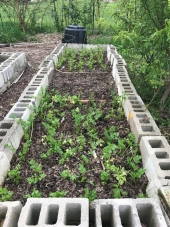posted 13 years ago
Raised boxes and cement are both major interests of mine for more than 20 years.
Flyash is available in types C and F. F is higher purity. Both are waste products from coal furnaces. Adding flyash to the concrete mix reduces the amount of cement by about a third.
Adding flyash also increases the strength and workability of the concrete. I do not know what type flyash is used by concrete block mfgs. I do know the processor of the limestone to make the Portland cement also makes the concrete block. These mfg plants are all around the country.
Concrete block, in my opinion, makes a good garden box. I made one ferrocement garden box 3ft x 13 ft by 20in deep. This is the middle of the 3rd season. I don't till, or add "processed" chemicals of any kind. It is doing great.
If you are really sensitive to certain chemicals, I suggest you call the manufacturer. Block is cheaper at the source, and you at least can ask questions of someone who may know.
Concrete block with a paver on top is very comfortable to sit upon while tending the garden.
I am in the process of making a strawberry planter using cardboard boxes, stucco mesh, and cement.
First I had an artist friend help arrange the boxes. I glued them into that shape. I painted the cardboard with a good primer. Then I covered all the surfaces with the mesh. I used rubber cement to attach the mesh. I added about (3) 1/8" layers of the cement mix. Without dirt or the little solar water fountain it weighs about 100 pounds, stands about 5 ft tall x 18in x 18in.
Another related thought regards separating the concrete block from the garden soil. Consider an old billboard vinyl. They are cheap, UV protected, and large enough to cover a lot. I have used 1 making 3 raised garden boxes. I used salvage welded wire electrical trays (U shaped - 6in x 1 ft x 6in 10ft long). I wrapped the billboard around the trays and put a 1x6 on top for a seat. They are doing great this year (their first). I think it would work well for a liner between the concrete block and the garden soil.
You might consider taking tree prunings and lining the inside of the boxes instead of plastic.
good luck
gary








